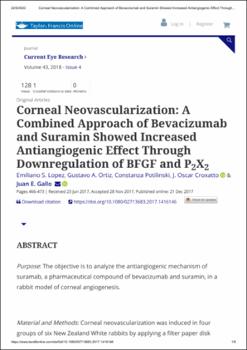Corneal Neovascularization: A Combined Approach of Bevacizumab and Suramin Showed Increased Antiangiogenic Effect Through Downregulation of BFGF and P2X2

View/
Date
2017-12-21Author
Lopez, Emiliano S.
Ortiz, Gustavo.
Potilinski, Constanza.
Croxatto, Oscar.
Gallo, Juan E.
Metadata
Show full item recordAbstract
ABSTRACT
Purpose: The objective is to analyze the antiangiogenic mechanism of suramab, a pharmaceutical compound of bevacizumab and suramin, in a rabbit model of corneal angiogenesis.
Material and Methods: Corneal neovascularization was induced in four groups of six New Zealand White rabbits by applying a filter paper disk soaked in 1 M Na (OH) on the central cornea. Group one was treated after injury with intravenous suramab at a dose equivalent to 3 mg/kg of bevacizumab and 10 mg/kg of suramin. Group two was treated with intravenous bevacizumab (5 mg/kg). Group three was treated with 10 mg/kg of suramin while the control group received no treatment. Digital photographs were taken at days 9, 15, 21, and 35. Neovessel formation was quantified giving a 0–4 score to each quadrant according to the centripetal growth of the longest vessel (neovessel index, NVI). Animals were sacrificed at day 35. Corneas were processed for histology, immunohistochemistry, and Western-blot using primary antibodies against P2X2, basic fibroblast growth factor (bFGF), LYVE-1, PECAM-1, and vascular endothelial growth factor-A (VEGF-A).
Results: Suramab significantly reduced neovessel growth (mean NVI: 4.2) compared to bevacizumab (8.4), suramin (7.22), and control animals (12.2) at 35 days post-injury (p < 0.01). A lower protein expression of P2X2, bFGF, LYVE-1, PECAM-1, and VEGF-A was found in the cornea of suramab animals than in the other groups of animals.
Conclusions: Joint downregulation of bFGF, P2X2, bFGF, and LYVE-1 constitutes a mechanism that induces greater and longer inhibition of corneal angiogenesis. Results might be relevant to ophthalmic care. Ocular administration of suramab is currently being investigated.

